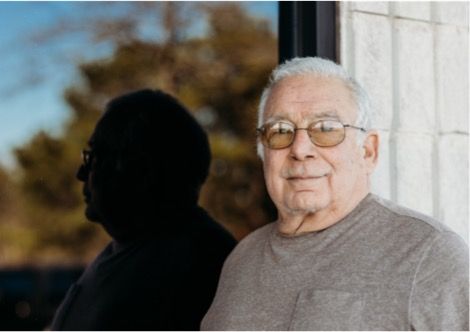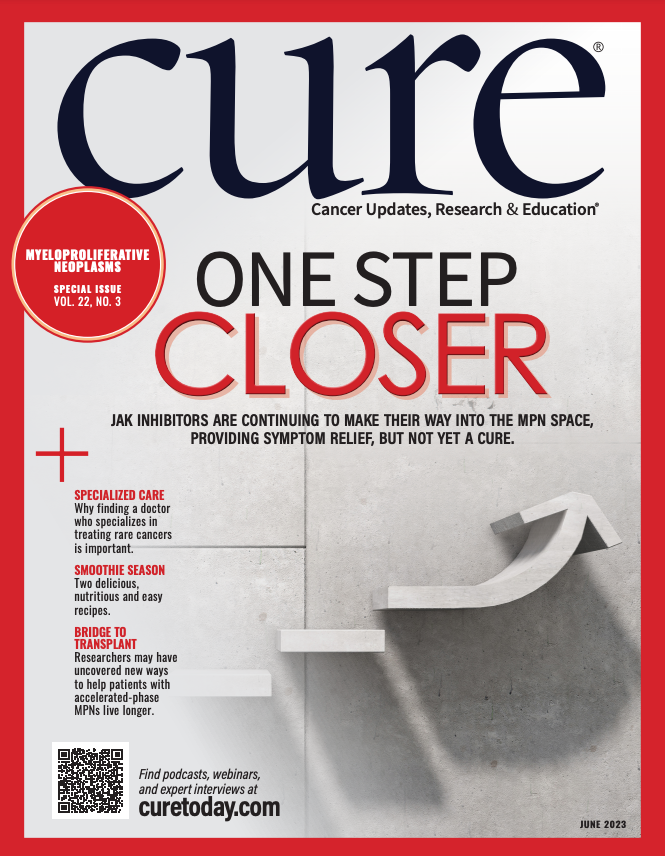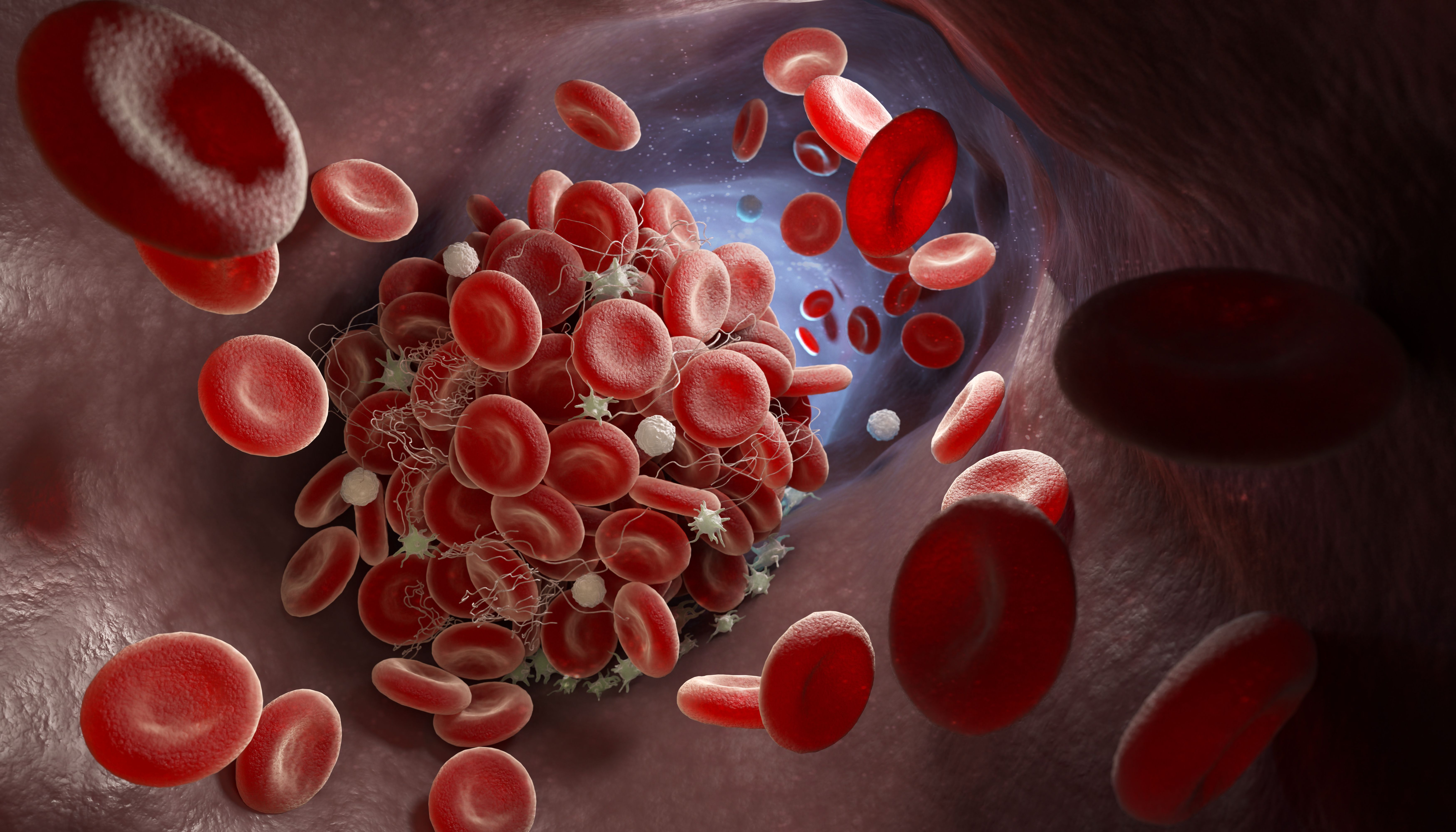Publication
Article
CURE
One Step Closer to an MPN Cure
Author(s):
Treatments with JAK inhibitors are continuing to make their way into the MPN space, providing symptom relief, but not yet a cure.
David Alexander was a passionate runner. He belonged to a running club, and regularly ran marathons. So when he found himself having trouble keeping up with his running buddies, he was concerned.
“I was marathon trained,” recalls Alexander, a lawyer for the Environmental Protection Agency in Washington, D.C., and a native of Queens, New York. “I was in good shape. I knew what I could do, but then I couldn’t do it.”
In addition to having trouble running, Alexander found himself experiencing “horrible brain fog.” He once caught himself looking for his keys as he got ready for work in the morning, searching all over the house before he realized they were in his hand. Other times he’d come home and find that he’d put the shredded wheat cereal in the refrigerator and the milk in the cupboard. Once, in trying to find his way through an unfamiliar area of New York, he realized he couldn’t read a map.
“In retrospect, I knew something was wrong with me,” says Alexander. So he went to see his doctor, who seemed unconcerned. Alexander recalls his physician asking: “What do you want me to diagnose you with? Not being able to run a marathon anymore?”
“He later apologized,” Alexander adds.
Within two days of taking a JAK inhibitor, David Alexander felt 20 years younger.
Photo by: Agne Sopyte

The answer came in 2005, when Alexander was participating in a medical trial run by the National Institutes of Health as a healthy volunteer. He was part of the study’s control group. Investigators left him a message asking him to call for the results of a blood test, but he put it off. When he got in touch, he learned that his hematocrit levels were “sky-high,” meaning that red blood cells constituted too large a proportion of his blood. He was told to get to a doctor soon. On his way out the door, a receptionist wished him good luck.
“I knew it was not the kind of ‘good luck’ I wanted to hear,” says Alexander. “But I was damn lucky.”
Alexander followed up on the advice and was diagnosed with polycythemia vera (PV), a rare blood cancer characterized by an excess of red blood cells that belongs to a group of diseases called myeloproliferative neoplasms, or MPNs.
In patients with MPNs, the bone marrow produces inappropriate amounts of different types of blood cells. Other examples of MPNs include essential thrombocythemia (ET), in which the blood contains too many platelets, and primary myelofibrosis (MF), in which a person’s bone marrow develops scar tissue, causing low red blood cell and platelet counts.
Symptoms of MPNs are varied and can include anemia, splenomegaly (an enlargement of the spleen that may cause abdominal pain, weight loss and loss of appetite), fever, night sweats, fatigue, cognitive difficulties and itchy skin. Patients with MPNs often experience a decline in their quality of life, and as many as half of myelofibrosis patients can become dependent on blood transfusions within a year of diagnosis. Worse than that is the possibility that an MPN can progress to life-threatening acute leukemia.
Twenty years ago, few registered treatment options existed for patients with MPNs. There were medications to help with symptoms, but nothing to address the diseases themselves. In recent years, however, a fairly new class of drugs called Janus kinase (JAK) inhibitors has offered relief, though not a cure, to the hundreds of thousands of people estimated to be living with MPNs, according to the MPN Research Foundation.
Meeting an Unmet Need
Although the famous hematologist William Dameshek posited the idea that MF, ET and PV were all related in 1951, it wasn’t until 2005 that several groups of researchers independently identified a mutation in the JAK2 gene as one genetic driver of these diseases. In the several years that followed, researchers also identified the roles of the MPL and CALR genes.
The first JAK inhibitor, Jakafi (ruxolitinib), was approved by the Food and Drug Administration (FDA) for treating MF in 2011.
“It really has not been around that long, when you consider other drugs that we’ve had forever,” adds Dr. Aaron Gerds, an assistant professor of medicine and deputy director for clinical research at Cleveland Clinic Taussig Cancer Institute in Ohio, who has worked as a principal investigator on several JAK inhibitor clinical trials. For example, compared with certain chemotherapy options, JAK inhibitors are practically brand new.
“The unmet need that JAK inhibitors fill is the ability to have an agent that significantly improves quality of life for the majority of patients, particularly in regard to constitutional symptoms and bothersome spleen-related symptoms,”
says Dr. Olatoyosi Odenike, a professor of medicine and the director of the leukemia program at University of Chicago Medicine who has also worked on studies of JAK inhibitors. “There is also a modest survival benefit,” she adds.
Like all cancers, MPNs are rooted in a problem with the mechanisms that control cell growth.
“The JAK2 protein is central to a number of processes in the body, but particularly blood cell production,” says Odenike. She adds that not all diseases that can be described as MPNs are suitable for treatment with JAK inhibitors. This class of drugs works specifically on what are called the “classical” MPNs: PV, MF and ET.
JAK inhibitors are oral drugs that block the JAK-STAT pathway, a signaling system in the body’s cells that regulates how the bone marrow produces blood cells.
“Patients with myeloproliferative neoplasms all have one unified theme of hyperactivity of the JAK-STAT signaling pathway that seems to be occurring in their bone marrow cells, and this is irrespective of the driver mutation present in these cells,” explains Dr. John Mascarenhas, a professor of medicine at Icahn School of Medicine at Mount Sinai in New York who has also worked on multiple JAK inhibitor trials. “We realized that this common theme of hyperactivity of the JAK-STAT signaling pathway could be interrupted by these small-molecule inhibitors, whereas previously, the treatments we gave were really nonspecific chemotherapies like hydroxyurea. This was a targeted therapy that depresses the activity of the signaling pathway, and in doing so, it quiets down the proliferation of cells that leads to problems in the disease.”
These corrections in cellular activity reduce many of the signs and symptoms associated with MPNs, such as an enlarged spleen and its related problems, making JAK inhibitors an ideal example of targeted cancer therapy, notes Mascarenhas. JAK inhibitors are also used in other hematological, rheumatologic and dermatological diseases, as well as in graft-versus-host disease, which occurs as a complication following transplants.
One of the most striking effects of JAK inhibitors is how quickly they can reduce a patient’s symptom burden.
“Folks who practiced before 2011 will often talk about patients with huge spleens, (who were) emaciated with loss of weight, fevers and night sweats, and incredibly short lifespans,” says Gerds. “And you would put them on these JAK inhibitors, and overnight, almost, it seemed like these people would have miraculous turnarounds.”
Not only were patients living better lives with major reductions in symptoms, but they were also living longer.
Alexander, who is president of the MPN Education Foundation, managed his PV without medication for 12 years. To lower his hematocrit counts, he underwent regular phlebotomy, or blood drawing. He began taking Jakafi after he developed pruritus, a severe, painful itching of the skin and a common symptom in MPNs.
“They call it itching,” he says. “I’m here to tell you, when it gets bad, it ain’t itching. It was life-stopping.”
The pain, he continues, was comparable to the worst sunburn imaginable topped off with being bitten by horseflies.
After Alexander began Jakafi treatment, his symptoms reduced in a matter of days. It particularly helped with the pruritus, but he says it did not help with episodes of transient global amnesia, a sudden, passing memory loss.
“Within a day or two, and I am not exaggerating, of taking the first pills, I just felt 20 years younger,“ he says. “My legs didn’t ache when I bounded up the steps at work. Within two days, according to my stopwatch, I could get up the steps faster.”
The Current Landscape of JAK Inhibitors
In 2014, three years after approving Jakafi for the treatment of patients with MF, the FDA approved the drug for the treatment of PV, making it the first drug specifically approved for that disease. The agency based its initial approval of Jakafi on two phase 3 clinical trials in which Jakafi outperformed both placebo and the best previously available therapy in reducing patients’ spleen sizes and overall symptom burdens. The 2014 expansion to use the drug for PV came on the heels of a study demonstrating that Jakafi reduced the need for phlebotomy among patients with PV and significantly reduced splenomegaly.
In 2019, a second JAK inhibitor, Inrebic (fedratinib), received FDA approval, also for MF related to MPNs, after study results showed that it significantly reduced spleen volume. Further, the clinical trial that served as the basis for Inrebic’s approval found that the drug reduced symptom burdens by more than half in about 40% of patients. Inrebic, Mascarenhas notes, can even be useful for patients whose treatment with Jakafi fails.
Joseph Cusati benefited from the approved JAK inhibitor Vonjo while participating in a clinical trial.
Photo by: Shannon Lee Photography

More recently, the FDA has approved Vonjo (pacritinib) for treating patients with myelofibrosis. And another JAK inhibitor, momelotinib, also shows promise for patients with MPNs and is the subject of a phase 3 trial.
One of Mascarenhas’ patients, Joseph Cusati, of Long Island, New York, received a diagnosis of MF in October 2019 and opted to participate in a trial of Vonjo rather than undergo a bone marrow transplant.
When he first began treatment, Cusati was told his red blood cell count was less than half of what it should be.
“I’d had nothing — absolutely nothing,” Cusati says when asked about his symptoms at the time of diagnosis. “I got a call from my primary physician who told me I had an issue with my blood. I went, and then they told me to go to the hospital. And I’ve been on this program ever since.”
He had heard of JAK inhibitors in passing as part of his job at HealthCare Partners. And when he looked up his diagnosis on the internet, he learned there was no cure.
“That was in the back of my mind, that I needed to make a decision one way or the other,” he says.
Although Cusati briefly considered a bone marrow transplant, he turned it down, in part because he wanted to avoid graft-versus-host disease.
“When you get a transplant, it’s not you that’s the problem,” he says. “It’s the bone marrow. Does it accept your body?”
Cusati received regular transfusions, usually about every week or two, early on in his treatment. But as the months on the study drug went by, he found he no longer needed transfusions.
“Whatever started to work is working,” he says. “It’s like a miracle. My energy level is astronomical. So, something is working.”
Although Cusati needed a wheelchair to move around the hospital during his early visits to see Mascarenhas at Mount Sinai, at his most recent visit, Cusati was able to walk everywhere he went. He can now spend two hours on an exercise bike at the gym.
Gerds notes that whereas many cancer drugs are approved based upon their effects on tumor size, the approval of JAK inhibitors for MPNs is based on reductions in symptoms and improvements in patients’ quality of life. He expects further innovations in the field of MPN treatment to include combining the drugs with other medicines.
Drawbacks and Limitations
JAK inhibitors also have their downsides. One major drawback is that because the drugs lower counts of certain blood cells, they can cause these counts to drop too low.
“If we are blocking JAK1 and JAK2 too much, we can cause worsening of anemia and thrombocytopenia: low red blood cells and low platelets,” says Gerds. “In someone with PV, that’s a wanted side effect. We’d want to control the red blood cell count. Same with ET: We’d want to control that platelet count. But for someone who’s already starting out with anemia and thrombocytopenia, it can certainly make that worse.”
For this reason, experts and patient advocates say that among the current options available, no JAK inhibitor is necessarily superior to another. Jakafi or Inrebic may not be safe for use in patients who have low platelet counts because they could reduce those low counts even further, so pacritinib will offer another option for those with thrombocytopenia. Momelotinib, says Mascarenhas, may be particularly useful for patients with transfusion-dependent anemia.
“It all depends,” says Alexander. “What is an undesired effect in one context (lowering counts) can be treatment in another context (PV)."
In Alexander’s case, Jakafi’s effect on his immune system meant he had to stop using the drug after two years and four months. He developed a dry cough and found himself struggling to bicycle up a small hill that was part of his usual morning commute. Eventually, doctors identified spots on his lungs and determined that he had an infection from Cryptococcus neoformans, a common fungus that occurs virtually everywhere in the world, which can be fatal in people who are immunocompromised.
To beat the infection and avoid similar ones in the future, Alexander had to stop taking Jakafi, which he describes as “very sad.” Treatment with the drug had been a positive experience, largely controlling his symptoms and shrinking his spleen.
“Would I take (Jakafi) again if I could? Sure enough,” says Alexander. “Would I suggest a fellow patient take it, based on my experience? Of course I would, with qualifications.”
Those qualifications, he adds, include being on the lookout for the risk of severe infections.
Beyond side effects, doctors say, one of the biggest caveats is that JAK inhibitors do not cause remission from MPNs.
“For all the good they do, they don’t, unfortunately, cure patients,” says Mascarenhas. “So the disease can continue and progress, despite (the patient) even enjoying some benefits of the drug.”
Odenike points out that the classical MPNs tend to progress to acute myeloid leukemia, which is much more aggressive. “(Researchers) shared the enthusiasm that (JAK inhibitors) would be tantamount to attacking these diseases at their root cause, which would lead to transformational effects,” she adds.
She and other researchers hoped that the medications could stop fibrosis, or scarring of the bone marrow, and perhaps even make the JAK2 mutation undetectable, possibly halting the progression to leukemia. None of this, she continues, has turned out to be true so far.
“It seems now, after 10 years of experience with JAK inhibi- tors, that this is not a realistic goal with this class of drugs in their current form,” Odenike explains.
In addition, although JAK inhibitors demonstrate some improvement in survival for patients who take them, Odenike has been somewhat disappointed by the results.
“We wanted so much more,” she says.
'Better Things Are Coming'
Alexander encourages anyone with PV or another MPN to consult with an expert because “your hometown internist isn’t likely” to have much experience with these diseases.
“For most people, you’re going to be managing a chronic disease and its symptoms, which can be annoying or more than annoying for a long time,” he says.
Alexander also emphasizes that although receiving a diagnosis of PV is an initiation into a club nobody wants to join, it is possible to live a long and fulfilling life with the disease.
“You’re going to have years and years in front of you,” says Alexander, who remains an active runner and cyclist. “We’ve all gone through the adjustment of having a disease (that) is indeed likely to be life-shortening. The way I think of it, I don’t think (about) my prognosis. According to what I read in the literature, at 17 years, I think I’m at my median prognostic lifespan. Which is ridiculous. I’m not done. I’m not close to done.“
Alexander adds, “Be glad you’re diagnosed in this modern era. Better things are here, and better things are coming for you.”
Gerds agrees. “The combinations that are forthcoming are really exciting,” he says.
A nonprofit group, the MPN Research Foundation, is dedicated to ongoing efforts to treat, and perhaps someday cure, these diseases.
In the MANIFEST trial, pairing Jakafi with another drug appears to significantly improve response rates and the durability of benefit. Another combination is showing responses even with relapsed or refractory disease, and still more combinations attack disease from multiple pathways at once.
“We’re expecting readouts from at least four or five randomized trials in the next year and a half,” Gerds says. “It’s an exciting time.”
For more news on cancer updates, research and education, don’t forget to subscribe to CURE®’s newsletters here.





